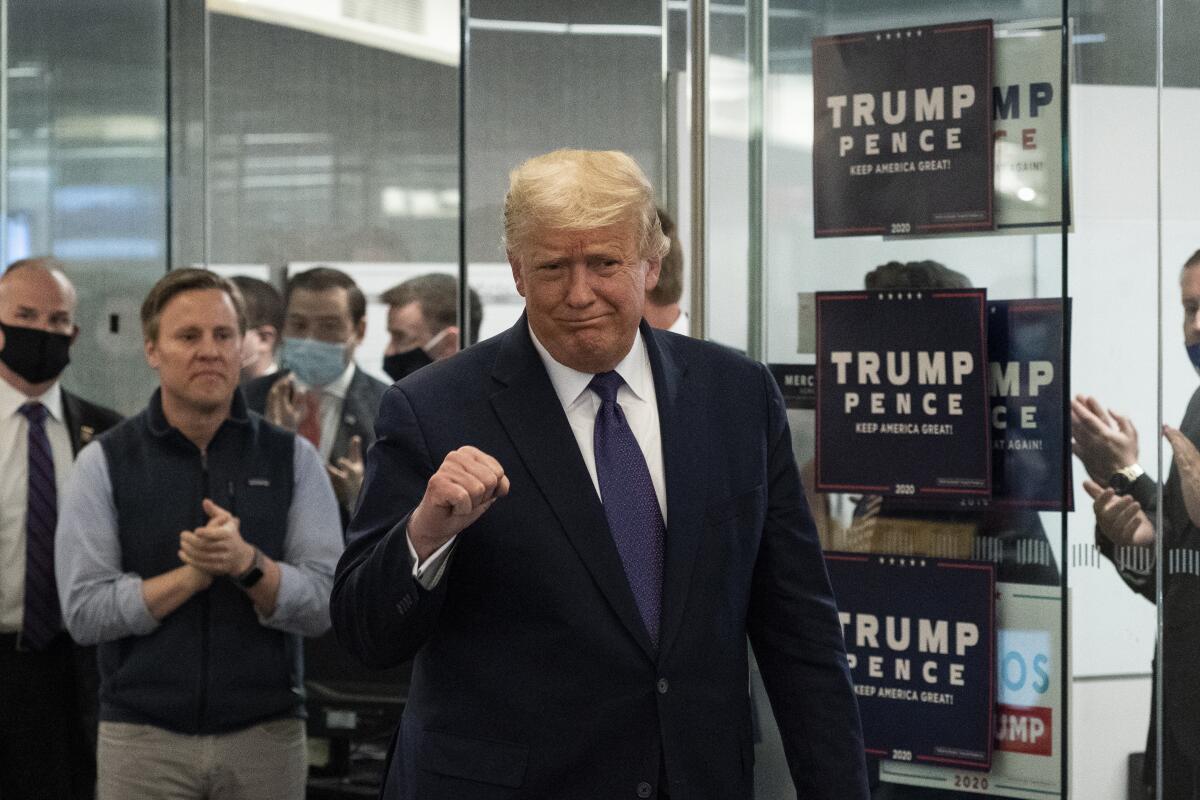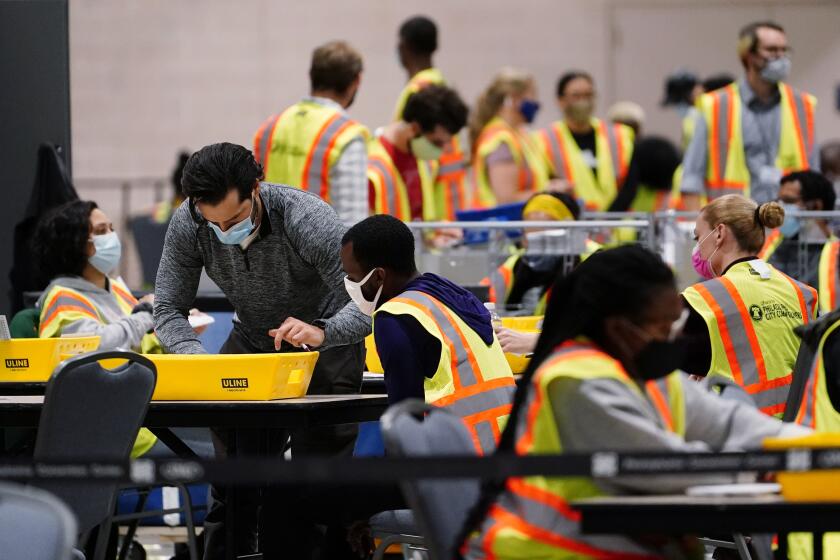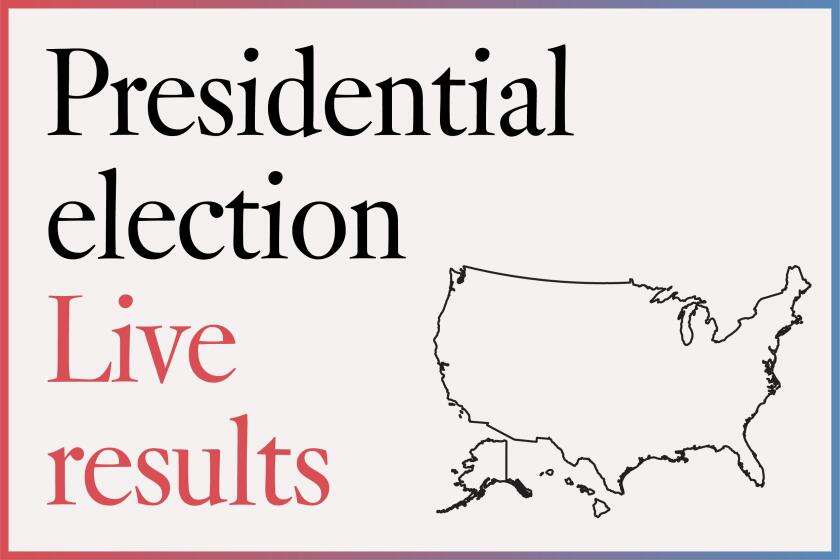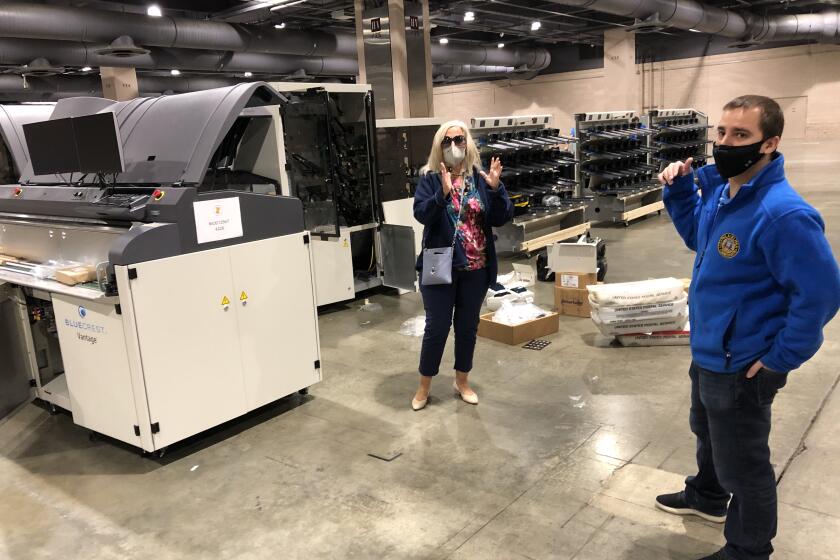Trump falsely claims ‘we have already won’ election and threatens to go to the Supreme Court

- Share via
President Trump delivered a hazy claim of victory early Wednesday morning over Democrat Joe Biden even as millions of votes remained to be counted, calling on the Supreme Court to “stop a major fraud on our nation” and hand him the presidential election.
In an extraordinary 2:30 a.m. appearance at the White House, Trump falsely asserted the pending outcome was “a fraud on the American public” and an “embarrassment on our country.”
“We were getting ready to win this election — frankly we did win this election,” he said, citing victories in states he lost or that had yet to be decided. “So we’ll be going to the U.S. Supreme Court. We want all the voting to stop; we don’t want them to find any ballots at 4 o’clock in the morning and add them to the list.”
“It’s a very sad moment,” Trump said gravely. “To me this is a very sad moment, and we will win this. And as far as I’m concerned, we already have.”
Before the president spoke, Biden told supporters he was confident he would prevail.
“We’re going to have to be patient until the hard work of tallying the votes is finished,” he said at a drive-in rally in his hometown of Wilmington, Del. “And it ain’t over until every vote is counted — every ballot is counted. But we’re feeling good.”
Democratic hopes for a blue wave that would sweep away barriers to progressive policy changes suffered a significant setback.
The prospect of a constitutional crisis in a country already torn apart by a scorchingly negative campaign was a nightmare many Americans had dreaded.
Legal experts expressed skepticism over Trump’s claims.
Edward Foley, an elections law expert at Ohio State University, said the president “is confused, if you want to treat it charitably.”
“What he describes doesn’t match the reality of the legal process as it applies to counting votes,” Foley said. “The votes will be counted in each and every one of these states. He doesn’t have any role to play in that as a candidate. And the office of the presidency doesn’t have any role to play in that.”
As the vote counting pushed into Wednesday morning, the political map looked strikingly as it did four years ago.
Once more, the contest appeared to narrow to three major industrial states — Michigan, Pennsylvania and Wisconsin — that delivered the presidency to Trump in 2016 even as he lost the popular vote to Hillary Clinton.
This time, it could take days to know the outcome, with millions of ballots to be tabulated. Most of those are early votes, which are likely to favor Biden; he pulled ahead in Wisconsin early Wednesday morning after votes from the Democratic-leaning Milwaukee area were counted.
Both candidates stood at more than 200 electoral votes, shy of the 270 needed to win the White House.
The fate of the presidency still hangs in the balance as President Trump and Joe Biden duel over a few remaining battleground states.
Biden easily won California as part of a West Coast sweep and carried other Democratic strongholds including Minnesota, which Trump targeted after a narrow loss four years ago.
The president once again carried Florida — the campaign’s biggest battleground — and prevailed in most of the GOP-leaning Deep South and other Republican bastions. He also won the Republican-tilting states of Ohio and Texas, where Biden made a late play.
That left just a handful of states to decide the cliff-hanging election.
Biden won Arizona, a state Trump narrowly carried four years ago that was a prime target of both sides.
Trump, who once more outperformed his showing in most opinion polls, was leading in the rest of the undecided states: Georgia, North Carolina, Michigan and Pennsylvania.
That was precisely what many Democrats feared, even as they pushed supporters of Biden and his running mate, California Sen. Kamala Harris, to flood the polls ahead of election day. (Trump, who cast doubts on early voting with threatened lawsuits and unsubstantiated allegations of fraud, encouraged his supporters to turn out en masse Tuesday.)
Biden, who led in the popular vote, told supporters in Wilmington, “We feel good about where we are.”
“We really do,” the Democrat said as his wife, Jill, clapped next to him and the crowd honked their car horns in a riverfront parking lot. “I’m here to tell you tonight we believe we’re on track to win this election.”
After Trump spoke, Biden’s campaign manager issued a statement echoing the Democrat’s earlier remarks.
“We repeat what the vice president said tonight: Donald Trump does not decide the outcome of this election. Joe Biden does not decide the outcome of this election. The American people decide the outcome of this election,” said Jen O’Malley Dillon. ”And the democratic process must and will continue until its conclusion.”
For some Democrats, election night had a stomach-churning familiarity. At the least, Biden was denied the electoral college landslide that some of his supporters had fantasized.
On Tuesday night, demonstrators wandered listlessly outside the White House as it became clear the preliminary counting would not deliver the thumping repudiation of Trump they had hoped for.
India Travis, 32, a hairdresser, sat on the sidewalk with a friend anxiously watching CNN on her phone. “If Biden won, I wanted to be here and around people,” she said.
Now she wasn’t so sure. “I felt more confident in the beginning than I do now,” Travis said.
In the fight for the Senate, Democrats picked up seats in Colorado, where former Gov. John Hickenlooper defeated freshman Republican Cory Gardner, and Arizona, where Mark Kelly beat Republican Sen. Martha McSally.
But those gains were offset by the defeat of Democratic Sen. Doug Jones in Alabama, who lost to former Auburn University football coach Tommy Tuberville.
In Iowa, GOP Sen. Joni Ernst beat back a strong challenge to win a second term while freshman Montana Sen. Steve Daines defeated the state’s Democratic governor, Steve Bullock, to hold onto his seat for Republicans.
The counting of mail ballots will be slow in Pennsylvania, a state that could decide the presidential race. Election experts are alarmed by the threat of civic unrest as Trump tries to undercut public faith in the result.
As expected, Majority Leader Mitch McConnell was reelected in Kentucky, and in South Carolina, Republican Lindsey Graham withstood a tidal wave of Democratic cash to win his fourth term.
Control of the chamber was still up for grabs, however, with several other competitive races undecided. Democrats need a gain of three seats if Biden is elected and four if Trump wins. (The vice president casts the tie-breaking vote in the Senate.)
Democrats, meanwhile, maintained their control of the House.
Turnout nationwide was robust, reflecting the sense of urgency attending a presidential election conducted under an extraordinary shadow — a deadly pandemic, economic collapse and an emotional debate over racial justice.
Not surprisingly, those issues surfaced as the main guide to voter preferences, according to exit polls conducted for a consortium of television networks.
About a third of those surveyed cited the economy as the most important issue in deciding their vote for president, and they overwhelmingly backed Trump. Just about 2 in 10 cited racial inequality, and they heavily supported Biden.
Slightly fewer, just under 20% of those surveyed, said the pandemic directed their choice, and they, too, backed Biden by a lopsided margin.
Opinions regarding the COVID-19 pandemic, which hung like a sickle over the campaign, served as a kind of Rorschach test that reflected the country’s deep polarization.
Trump minimized the virus and scoffed at safety measures, such as wearing a face covering in public, even after being hospitalized last month with COVID. He said it was far more important to rally the economy, even if it mean a greater spread of the virus.
Biden modeled caution — he pulled off a mask before speaking to the drive-in crowd Tuesday night — and followed health guidelines as he traveled the country, turning Trump’s attitude into a central focus of his campaign.
The divisions were stark: More than 4 in 5 Biden voters said efforts to fight the pandemic, which has killed more than 232,000 Americans, were going badly. Only 1 in 10 Trump supporters felt that way.

Despite widespread fears of election-related violence, the voting Tuesday was mostly peaceful.
Scattered reports turned up some incidents of targeted misinformation and other mischief aimed at keeping voters from the polls, but those did nothing to dampen enthusiasm on a day many had circled in red ink.
Total voter turnout is expected to surpass records in many states and perhaps nationwide. Even before the polls opened Tuesday, more than 100 million Americans had cast their ballots in person or by mail, a measure of the enthusiasm on both sides and precautions some took to avoid the risk of COVID-19.
To ensure every one of those votes is counted, a federal judge ordered the U.S. Postal Service to sweep its facilities for outstanding ballots and rush the delivery of any that were found. Postal Service officials said they lacked the personnel to fully comply.
Voters were waiting outside polling places nationwide even before the sun rose; the lines they formed could be measured in terms of football fields or city blocks.
Sisters Rubria Toscano, 74, and Martha Melcher, 67, waited three hours at a community center in Henderson, Nev., just outside Las Vegas, to cast their ballots for Trump.
“We voted, we used our voices,” said Melcher, who wore a bright red fedora, on which she proudly placed an “I Voted” sticker.
Kamaria Brooks, 40, waited months until she felt it was safe to fly home from Houston, where she has sheltered during the COVID-19 pandemic. The Biden voter went straight from John Wayne Airport to her polling place in Irvine.
“I refused to miss today. I need my voice to be heard,” said Brooks, who was clad head to toe in Black Lives Matter regalia. “There’s a lot of stuff that impacts me and my community.”
While the vote count was creating drama, the balloting proved far more peaceable than some had feared.
Misdirection and misinformation occur every election. There was heightened concern this time, owing to Russia’s interference in the 2016 election and efforts by Trump to undermine confidence in the balloting by, among other things, making false claims about voter fraud and the illegitimacy of mail-in ballots.
But for all the worries over armed intimidation, marauding militias and other threats of election day violence, law enforcement officers and vote monitors reported nothing extreme or out of the ordinary.
Times staff writers Stephanie Lai in Irvine, Melanie Mason in Wilmington, Chris Megerian in Washington, Brittny Mejia in Las Vegas, Michael Finnegan in Philadelphia and Matt Pearce in Los Angeles contributed to this report.
More to Read
Get the L.A. Times Politics newsletter
Deeply reported insights into legislation, politics and policy from Sacramento, Washington and beyond. In your inbox three times per week.
You may occasionally receive promotional content from the Los Angeles Times.














